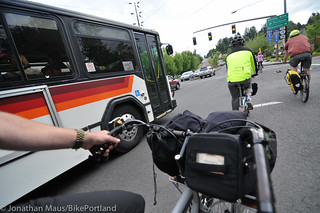After five years of service cuts and rapid fare hikes, people who ride TriMet are getting a measure of relief.
The regional transit agency’s board voted Wednesday to bring 10 of its 12 frequent-service bus lines — the 6, 8, 9, 12, 14, 15, 33, 54/56, 57 and 75 buses — back up to the agency’s standard of 15 minutes or fewer between buses during midday hours. (TriMet’s two most-ridden lines, the 4 and 72, already meet that standard.)
It’s also considering an advocacy group’s campaign to extend transfer times from two to three hours, softening the bite of recent fare hikes for people who pay cash for short round trips.
We’ve been watching TriMet’s budget rollercoaster for years, asking in both 2011 and 2012 whether worse transit would lead to more biking. And though the answer is complicated, years of transit cuts since 2008 don’t seem to have done much to citywide biking rates, which haven’t budged since 2008.
The agency says the additional bus service-hours required will cost about $3.1 million annually, counting additional fare revenue on the lines. Bringing every frequent bus line back to its 2008 frequencies during both day and evening hours would cost more: a total of about $7.8 million, the agency figures.
TriMet’s annual operations budget, which doesn’t include new construction, is $489 million, two-thirds of which goes to driving and maintaining its buses and light rail lines.
“My focus has been to restore Frequent Service, and I’m so pleased we found savings in our current budget to allow us to reinvest in this network,” TriMet General Manager Neil McFarlane wrote in the agency’s news release.
Bus Riders Unite, the transit riders’ group organized by OPAL Environmental Justice, applauded what its associate director called an “incremental” service improvement, but said that frequent bus service should be coupled with extending fare transfer times to three hours, long enough for more midday round trips and multi-transfer rides across the region.
Though the relationship between biking and transit is hard to pin down, every city in the developed world that’s known for good biking also has frequent, reliable and popular mass transit.
“While there are many good reasons to increase frequent service lines, equity isn’t one of them,” OPAL Associate Director Vivian Satterfield wrote. “Some frequent service lines serve a lot of low-income people and people of color, but others don’t. … The equity case for longer transfer times is quite clear, and is an essential complement to incremental service changes.”
Extending transfer times would have the biggest appeal for people who don’t ride transit enough to buy monthly or weekly passes, who don’t have enough money at one time to buy a pass, or who frequently use it for round trips that aren’t work commutes.
Satterfield said she was “confident” that a board member would introduce a formal proposal next month to extend transfer times, and that the board seems open to “tackling” the issue.
Though the relationship between biking and transit is hard to pin down, every city in the developed world that’s known for good biking also has frequent, reliable and popular mass transit. That may be because bike and transit trips combine with each other well; it may be because, in combination, they make car ownership less important; and it may be because good transit helps free up road space that can be used to improve biking.
As we write frequently, people aren’t obsessively loyal to one mode or another; they switch fluidly among buses, cars, bikes, feet and skating based on lots of factors. Back in 2009, just before TriMet started hacking into its frequent service buses, we wrote that Portland was “primed for a low-car diet.” Hopefully these moves by TriMet are among the many factors it’ll take to get us back on that wagon.


